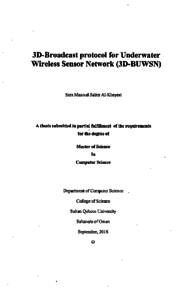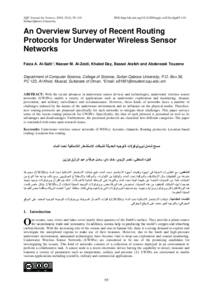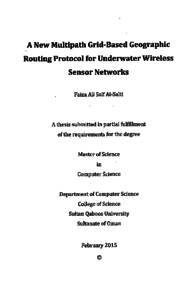Document
3D-Broadcast protocol for underwater wireless sensor network (3D-BUWSN).
Publisher
Sultan Qaboos University
Gregorian
2016
Language
English
Subject
English abstract
In this research, we developed a new broadcast protocol for UWSN called Three Dimensional Broadcast Protocol for Underwater Wireless Sensor Network (3D-BUWSN). 3D-BUWSN tries to achieve high reachability rate, less energy consumption and good end-to-end delay. All sensors are deployed in 3D space at different depth equipped with localization service to determine position of the sensor node in the network. To avoid broadcast storm problem, 3D-BUWSN privileges the re-broadcast operation to the farthest nodes from the forwarder.
3D-BUWSN has been evaluated through developing a simulation model in Aqua-Sim simulator which is used to evaluate underwater sensor networks. We compare its performance with Vector-Based Forwarding as Broadcast (VBFB) and Probability-based method. The simulation results show that 3D BUWSN is the best in achieving higher reachability compared to VBFB and Probability-based methods. In terms of both consumed energy and end-to end delay, 3D-BUWSN and probabilistic approach are close. VBFB shows better consumed energy but at the cost of high end-to-end delay and low reachability.
Member of
Resource URL
Arabic abstract
تهدف هذه الأطروحة إلى اقتراح وتطوير نظام جديد للرسائل الجماعية في شبكة المتحسسات اللاسلكية المستخدمة تحت سطح المياه المقترح الجديد اطلقنا عليه اسم نظام الرسائل الجماعية الثلاثي الأبعاد في شبكة المتحسسات اللاسلكية المستخدمة تحت سطح المياه. هذا المقترح يهدف إلى إيصال الرسالة إلى جميع المتحسسات في زمن مقبول وباستخدام طاقة أقل. يفترض هذا المقترح أن جميع المتحسسات تم وضعها على أعماق مختلفة ومزودة بآلية لتحديد موقعها. كما أنها تمتلك مميزات وخصائص متشابهة كخط الإرسال ومستوى الطاقة الأولي. كل رسالة جماعية لها معرف خاص يتكون من المعرف الخاص بالمتحسس ورقم تسلسلي. من خلال هذا النظام، حصرنا عملية إعادة الإرسال إلى المتحسسات الأبعد من المصدر فقط كي نمنع مشكلة عاصفة الرسائل الجماعية تمت دراسة جدوى هذا النظام المقترح من خلال نظام المحاكاة المعروف ب " Aqua - Sim " والذي صمم خصيصا لدراسة المتحسسات تحت سطح المياه. أوضحت النتائج أن النظام المقترح هو الأفضل في تحقيق أعلى نسبة في إيصال الرسالة لجميع المتحسسات. كذلك أظهرت النتائج أن الطاقة المستهلكة و زمن إيصال الرسالة في كل من نظام الرسائل الجماعية الثلاثي الأبعاد في شبكة المتحسسات اللاسلكية المستخدمة تحت سطح المياه و الطريقة القائمة على الاحتمال متقاربة جدا. في حين VBFB كان الأمثل في استهلاك طاقة أقل ولكن على حساب زمن عالي جدأ في إيصال الرسالة وتحقيق نسبة منخفضة في إيصال الرسالة.
Category
Theses and Dissertations



